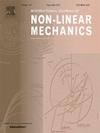Torsional vibration behavior of compressor shaft system considering variable inertia characteristics of crank-connecting rod mechanisms
IF 2.8
3区 工程技术
Q2 MECHANICS
International Journal of Non-Linear Mechanics
Pub Date : 2024-12-19
DOI:10.1016/j.ijnonlinmec.2024.104997
引用次数: 0
Abstract
The differential equation for the torsional vibration of the shaft system, which takes into account the variable inertia and nonlinear friction of the cylinder, has been established. This study investigates the influence of the connecting rod ratio, motor speed, reciprocating mass of the piston assembly, and cylinder damping on the vibration characteristics of the shaft system. First, the expression for the instantaneous moment of inertia of the crank-connecting rod-piston mechanism, which accounts for the connecting rod ratio, has been derived. Second, an experimental study on the vibration of the shaft system was conducted. The results indicated that the relative error between the numerical model calculations and the experimental data was 8.2%, demonstrating that the numerical model possesses good computational accuracy. Subsequently, the impact of the connecting rod ratio on the unbalance moment, torsional stress, and speed inhomogeneity within the shaft system was investigated. The findings reveal that an increase in the connecting rod ratio leads to an increase in the amplitude of these three parameters, and that the vibration energy shifts from low frequencies to high frequencies. The shaft system is more susceptible to high-frequency resonance phenomena, which can lead to velocity inhomogeneity and result in distortion phenomena. Ultimately, the effects of rotational speed, reciprocating mass of the piston assembly, and cylinder damping on the vibration behavior of the shaft system were analyzed using bifurcation and phase trajectory diagrams. The results indicate that a high rotational speed r/min is beneficial for controlling the vibration behavior and amplitude of the shaft system. A moderate reciprocating mass kg can maintain the shaft's vibration behavior and amplitude within an optimal range. Enhancing the cylinder damping can transform it into an energy-dissipating element, thereby improving the vibration behavior of the shaft system. The research findings presented in this paper not only offer guidance for the design of the crank-rod structure but also provide a means to control the shaft system's vibration amplitude, preventing the occurrence of the "burning tile" phenomenon.
求助全文
约1分钟内获得全文
求助全文
来源期刊
CiteScore
5.50
自引率
9.40%
发文量
192
审稿时长
67 days
期刊介绍:
The International Journal of Non-Linear Mechanics provides a specific medium for dissemination of high-quality research results in the various areas of theoretical, applied, and experimental mechanics of solids, fluids, structures, and systems where the phenomena are inherently non-linear.
The journal brings together original results in non-linear problems in elasticity, plasticity, dynamics, vibrations, wave-propagation, rheology, fluid-structure interaction systems, stability, biomechanics, micro- and nano-structures, materials, metamaterials, and in other diverse areas.
Papers may be analytical, computational or experimental in nature. Treatments of non-linear differential equations wherein solutions and properties of solutions are emphasized but physical aspects are not adequately relevant, will not be considered for possible publication. Both deterministic and stochastic approaches are fostered. Contributions pertaining to both established and emerging fields are encouraged.

 求助内容:
求助内容: 应助结果提醒方式:
应助结果提醒方式:


